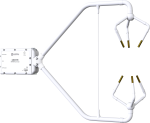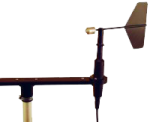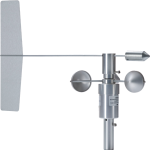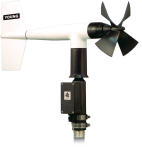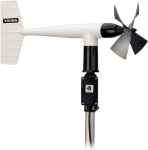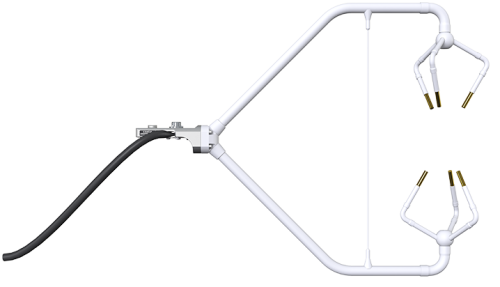
フラックスやその他の高レベル乱流研究プロジェクトに最適な機器






概要
CSAT3A 3D超音波風速計は、渦共分散測定に最適な3D音波風速計です。空気力学的設計、10cmの垂直測定経路、パルス音響モードで動作し、過酷な気象条件にも耐えます。直交する3つの風成分(ux、uy、uz)と音速(c)が測定され、最大50Hzで出力されます。CSAT3AヘッドはEC100エレクトロニクスで操作し、EC150またはEC155ガス分析計も制御します。
測定は2つのソースからトリガーできます:
- データロガーのSDMコマンド
- EC100の内部クロック
SDMプロトコルは、複数のCSAT3Aを同期させるためのグループトリガをサポートしています。
続きを読む利点と特徴
- 新しいコンフォーマルコーティングは、腐食性環境での音響トランスデューサの保護をする
- 革新的な設計により、流れの歪みを最小限に抑えながら高精度の乱流測定を実現
- 通常は EC150 または EC155 ガス分析装置と組み合わせて、渦共分散測定のほぼ完全なコロケーションを実現
- ほとんどの Campbell Scientific データロガーとの互換性あり
- 測定値を使用して、運動量フラックスと摩擦速度を計算可能
- Campbell Scientific の細線熱電対は、高速応答温度測定のオプション
- 屋外での耐久性
- 革新的な信号処理とトランスデューサウィックにより、雨天時の風速計のパフォーマンスが大幅に向上
- 密閉された音響トランスデューサと電子機器
イメージ



詳細
CSAT3A は、EC150 オープンパスまたは EC155 クローズドパス CO 2 /H 2 O ガス分析装置のオプション コンポーネントです。共通の取り付けブラケットに取り付けられ、ガス分析装置の EC100 電子モジュールに接続されます。
仕様
| 測定経路長 |
|
| 水平からの経路角度 | 60° |
| 構造 | 密閉型音響トランスデューサおよび電子機器 |
| 風速計ヘッドの材質 | ステンレス鋼チューブ |
| 電子ボックスの材質 | 溶接アルミニウム |
| 動作温度範囲 | -30° ~ +50°C |
| 電圧供給 | 10 ~ 16 Vdc |
| 電流 |
|
| デジタル SDM 出力信号 | データロガー/センサ通信用 CSI 33.3 k ボー シリアル インターフェイス (データタイプは出力ごとに 2 バイトの整数と 2 バイトの診断です。) |
| サポートアームの直径 | 1.59 cm (0.63 in.) |
| トランスデューサの直径 | 0.64 cm (0.25 in.) |
| トランスデューサ取り付けアームの直径 | 0.84 cm (0.33 in.) |
| 風速計ヘッドの寸法 | 47.3 x 42.4 cm (18.6 x 16.7 in.) |
| 風速計ヘッドの重量 | 1.7 kg (3.7 lb) |
測定 |
|
| 出力 |
ux、uy、uz、c (ux、uy、uz は風速計の軸を基準とした風の成分、c は音速です。) |
| 音速 | 3 つの音響経路から決定され、横風の影響が補正されます。 |
| 測定速度 | 1 ~ 60 Hz でプログラム可能、瞬時測定。 2 つのオーバーサンプリング モードは、20 Hz または 10 Hz にブロック平均化されます。 |
| 出力帯域幅 | 5、10、12.5、20 Hz |
| 出力速度 | 10、20、25、50 Hz |
| 測定分解能 |
|
| 測定解像度 |
|
| オフセット誤差 |
|
| ゲイン誤差 |
|
| 雨 | 革新的な超音波信号処理とユーザーが取り付け可能なウィックにより、あらゆる降雨状況下での風速計の性能が大幅に向上します。 |
デジタルUSBとRS-485出力信号 |
|
| ボーレート | 230400 bps (最大) |
| データタイプ | カンマ区切りの ASCII |
| フルスケール風速 | 4 つの範囲間で ±65.535 m/s 自動範囲設定 (最下位ビットは 0.25 ~ 2 mm/s です。) |
| 音速 | 300 ~ 366 m/s (-50° ~ +60°C) 最下位ビットは 1 mm/s (0.002°C) です。 |
ドキュメント
マニュアル
- EC150 CO2 and H2O Open-Path Gas Analyzer and EC100 Electronics with Optional CSAT3A 3D Sonic Anemometer
- Open Path Eddy Covariance System with IRGASON or EC150/CSAT3A Quick Deploy Guide
- EC155 CO2 and H2O Closed-Path Gas Analyzer and EC100 Electronics with Optional CSAT3A 3D Sonic Anemometer
- CPEC306/310 Closed-Path Eddy-Covariance Systems
動画とチュートリアル
よくある質問
CSAT3Aに関するよくある質問の数: 22
すべて展開すべて折りたたむ
-
いいえ。オフセットは温度と時間の関数です。年に一度、T3CSAT3B の取扱説明書に記載されている手順を使用して、音波風速計の風オフセットを抜き取り検査してください。測定されたオフセットが仕様外の場合は、校正のためにセンサを工場に返送してください。返品承認 (RMA) 番号をリクエストするには、修理と校正のページに記載されている手順に従ってください。
-
CSAT3A または CSAT3B は、-30° ~ +50°C の温度範囲で校正されています。音波風速計の動作温度範囲は、-40° ~ +40°C の範囲をカバーするために 10 度シフトできます。低温アプリケーションの場合は、当社の音波風速計の加熱バージョンを検討する方が適切かもしれません。
機器は、信号が弱くなりすぎるまで校正された温度範囲外で動作し続けます。ただし、校正ファイルは指定された温度範囲のみを対象としているため、適切な校正は測定に適用されません。
-
The CSAT3/3A/3H is compatible with three output signals: analog, RS-232, and Synchronous Device for Measurement (SDM). The sonic anemometer can be interfaced to any data-acquisition system that is compatible with analog measurements or RS-232 serial communications. SDM is used with Campbell Scientific data loggers.
-
Campbell Scientific では、音波風速計センサ ヘッドを簡単かつ頻繁に配置できる取り付けブームやハードウェアは提供していません。このタイプのハードウェアはユーザーが用意する必要があります。
-
CSAT3A、CSAT3AH、CSAT3B、および CSAT3BH は、トランスデューサの遅延が風速に与える影響、および程度は低いものの音速測定への影響について、温度に対して較正されています。
超音波風速計には NIST 追跡可能な規格はありません。
-
はい。マッチング層が破損または欠落している場合は、修理のために音波風速計を工場に返送してください。修理および校正ページに記載されている手順に従って、返品承認 (RMA) 番号をリクエストしてください。
-
いいえ。音波風速計は風の測定値とともに時間を報告しません。風データには、データロガーまたは PC などのデータ収集システムによってタイムスタンプが割り当てられます。
-
Yes. The bubble level can be replaced in the field using pn 31962, 1-Ring Replacement Bubble Level with Mounting Bumper and Hardware.
-
The sensors used in the eddy-covariance application are not compatible with SCWin. An open-path eddy-covariance program is available for purchase as pn 18442, CRBasic Basic Eddy Covariance Program. This is the program without energy balance sensors. Also available is pn 18443, CRBasic Extended Eddy Covariance Program, with energy balance sensors. To order a custom configured program, contact the Environmental Group for assistance.
-
CSAT3A、CSAT3AH、CSAT3B、CSAT3BH は、他の音波風速計と同様に、超音波信号を使用して音波経路に沿った風速を測定します。塩水噴霧によって音波経路が遮断されると、音波風速計は測定できなくなります。トランスデューサの表面に厚い塩の層が堆積した場合も同様です。
ケーススタディ
森林生息地は、他のどの陸上バイオームよりも炭素循環とプロセスに貢献しています。地球の陸上に貯蔵されている炭素の半分以上が、森林生態系の幹、枝、葉、根、土壌に貯蔵されていると考えられています。炭素吸収源としての重要性を考えると、科学界では、さまざまな森林生息地、および同様の特性を持ちながらも樹齢が異なる森林における総炭素隔離を理解し、定量化することがますます急務となっています。 2001 年、学界、カナダ政府機関、民間部門のパートナーシップにより、ブリティッシュ コロンビア州バンクーバー島のアイランド ティンバーランドにある 13 年物のダグラスモミ林に高さ 20 メートル (65 フィート) のフラックス タワーが設置されました。この設置は、ダグラスモミの伐採サイクル生産性に関する長期的クロノシーケンス研究の一環です。ブリティッシュ コロンビア大学の科学者は、2001 年以来、渦相関 (EC)......続きを読む
科学者や土地利用管理者は、炭素吸収における森林地帯の重要性を長い間認識してきました。研究と国際政策は主に熱帯林と生息地に焦点が当てられてきました。熱帯林と生息地は成長が早く、頻繁な伐採の影響を受けやすいためです。しかし最近では、安定的に炭素を吸収して貯蔵できる生息地が地球全体の炭素状況の重要な部分であると認識されるようになり、寒帯地域などの冷涼な気候の景観に研究の焦点が当てられるようになりました。これらの地域では成熟した森林と気温によって分解速度が制限されるため、気候変動がこれらの景観を変える潜在的な影響により、景観をより完全に理解するための取り組みが強化されています。 アラスカ大学フェアバンクス校の研究者らは、米国地質調査所の資金援助を受け、国立科学財団の長期生態学研究ネットワークの一部であるボナンザ クリーク実験林内の 3 か所の環境モニタリング サイトに機器を設置しました。これらのサイトは、微気候の違いによって決まる陸上北方景観の重要な生息地を代表する永久凍土の劣化の年代順に位置しています。3 つのサイトには、クロトウヒ林 (クロトウヒの森がそのまま残っている安定した永久凍土の地域)、永久凍土が下にある地表の氷が溶けて樹木がかなり枯死している活発なサーモカルスト サイト、活動層の深さが深く安定した樹木のない湿原サイトが含まれます。 このプロジェクトの目標は、北極圏の気候システムにおける地表、大気、海洋間の重要なつながりとフィードバックである炭素、水、エネルギーのフラックスを年間を通じて継続的に測定することです。これまで、北極圏では環境条件が厳しく、遠隔地へのアクセスが困難なため、このような研究はほとんど行われていません。冬季に太陽光発電が限られ、風力発電が実行可能な選択肢ではない場所で継続的に監視するには、電力要件が極めて低く、リモート システム診断機能を備えた堅牢なセンサーを選択する必要があります。 Bonanza Creek サイトで、渦相関フラックス測定に Campbell Scientific の EC150......続きを読む
記事とプレスリリース
ブログ記事
-
Why Should You Use a Heated Sonic Anemometer?

19-11-2019 著者: Robin Deissinger
ニュースレター記事
Privacy Policy Update
We've updated our privacy policy. 詳細はこちら
Cookie Consent
Update your cookie preferences. クッキーの設定を更新する
